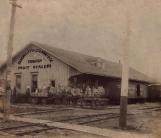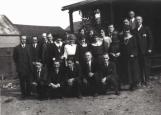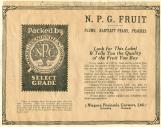14
THE SECOND GRIMSBY PRE-COOLING STATIONOn October 29, 1913, the "Grimsby Independent" officially announced the construction of the second Government Pre-cooling Station in Grimsby. It was built on Livingston Avenue by Daniel Marsh and Sons, a local Grimsby firm. In 1914, the Department of Agriculture opened the Experimental Pre-Cooling and Fruit Storage Plant at Grimsby, Ontario. Once the fruit storage warehouse was in use, it was said that thirty-nine cars of pre-cooled fruit were handled and assembled over three or four days.
15
Portion of 1928 Fire Insurance Map Showing Growers' Cold StorageApril 1928
Growers' Cold Storage and Ice Company Ltd., Livingston Avenue, Grimsby, Ontario, Canada
 Credits:
Credits:Risk Management Services
Grimsby Museum Collection
16
Growers' Cold Storage and Ice Co. Ltd.20th Century, Circa 1925
Growers' Cold Storage and Ice Company Ltd., Livingston Avenue, Grimsby, Ontario, Canada
 Credits:
Credits:Grimsby Museum Collection
17
When Nature Smiles - The Grimsby Pre-cooling Plant20th Century, Circa 1918
Growers' Cold Storage and Ice Company Ltd., Livingston Avenue, Grimsby, Ontario, Canada
 Credits:
Credits:Produced By the Canadian Government Motion Picture Bureau, Circa 1918. Copyright: National Film Board of Canada
18
The warehouse pre-cooling plant had 27,000 cubic feet of refrigerated space. The station was designed with four refrigerated rooms each capable of holding one car-load of fruit loaded on trucks. The plant was designed to cool fruit from 70 degrees Fahrenheit to 40 degrees in twenty-four hours using forced air circulation. This allowed the plant to cool approximately three train car loads per day while employees assembled eight more loads.Warm fruit, brought from the orchards, was loaded onto specifically designed trucks. The trucks were rolled into the cooling room where the floors were perforated to allow the cold air to circulate. After the fruit was loaded into train cars, the doors were sealed with sulphite paper ensuring the fruit was kept cool until it reached the customer.
19
The General Cold Storage Room of the Cold Storage Building20th Century, Circa 1914
Growers' Cold Storage and Ice Company Ltd., Livingston Avenue, Grimsby, Ontario, Canada
 Credits:
Credits:Grimsby Museum Collection
20
The advantages of using the pre-cooling station included fruit arriving in the best condition with less waste, the extension of the shipping distance and the ability to control the amount of fruit shipped at any given time, reducing market saturation. The use of the pre-cooling station helped to increase profits. The pre-cooling station also conducted experimental tests on related topics. The facility was purchased by the Growers Cold Storage and Ice Company Limited in 1921.21
Growers' Cold Storage and Ice Company Ltd. Advertisement31 October 1957
Growers' Cold Storage and Ice Company Ltd., Livingston Avenue, Grimsby, Ontario, Canada
 Credits:
Credits:Grimsby Museum Collection
22
PACKING AND SHIPPING HOUSESTHE GRIMSBY TRAIN STATION BECOMES A SHIPPING HOUSE
The original train station was built in 1855 to serve the Great Western Railway. This building which contained the ticket office, express and freight sheds and complete living quarters for the station master was originally located next to the main rail line. It was moved when a new station was built around 1900. A spur line was added to access the original station.
After 1900 the original station was first used by H. K. Griffity and Fred Woolverton as a fruit wholesale warehouse, then as a fruit shipping depot for Randall and Falconbridge. In subsequent years the building was used by The Ontario Co-operative and then the Canadian Fruit Company. The Niagara Peninsula Growers owned this building from 1921 to 1924 and then from 1925 to 1985 it was owned and operated by Niagara Packers Limited.
23
Grimsby's First Train Station19th Century, Circa 1855
Train Station, Grimsby, Ontario, Canada
 Credits:
Credits:Grimsby Museum Collection
24
Randall and Falconbridge Fruit Dealers20th Century, Circa 1908
Train Station, Grimsby, Ontario, Canada
 Credits:
Credits:Grimsby Museum Collection
25
NIAGARA PENINSULA GROWERSAfter the First World War, many growers were dissatisfied with the price they could receive selling their produce individually but with the formation of an organization to represent the growers, local farmers were able to obtain fair value for their crops. The Niagara Peninsula Growers Organization was formed in 1921. This was a member organization that provided local growers with a recognizable name to use for shipping their fruit across the country and overseas. In 1924, The "Grimsby Independent" reported the disbanding of the Niagara Peninsula Growers Organization citing dissatisfaction by the members with the representation provided for them.
26
Staff of the Niagara Peninsula Growers1921-1924
Grimsby, Ontario, Canada
 Credits:
Credits:Grimsby Museum Collection
27
N. P. G. (Niagara Peninsula Grower's) Fruit Advertisement1923
Ontario, Canada
 Credits:
Credits:Grimsby Museum Collection